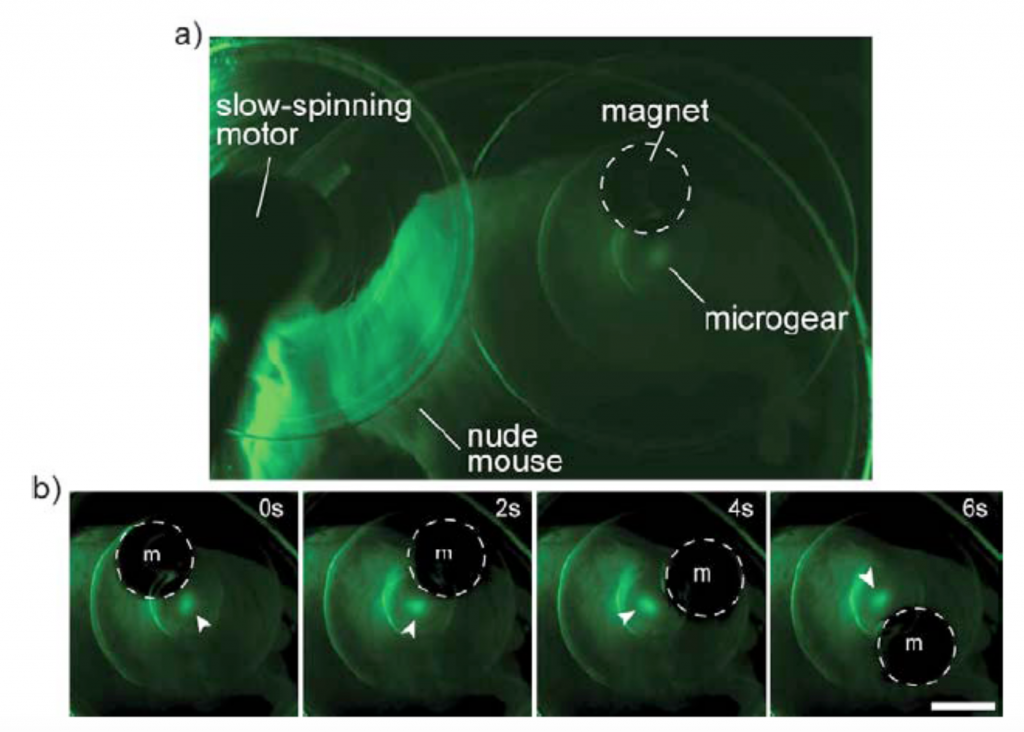Shrunken robotics that can travel inside the body and fix problems are a favourite trope not only of cartoons and science fiction (think Simpsons Treehouse of Horror XV: the family fly a spaceship inside Mr. Burns to find Maggie), but also the reality of modern medical research. A team from at Columbia University, composed of Sau Yin Chin, Yukkee Cheung Poh, Anne-Céline Kohler, Jocelyn T. Compton, Lauren L. Hsu, Kathryn M. Lau, Sohyun Kim, Benjamin W. Lee, Francis Y. Lee and headed by professor Samuel Sia, have developed a liquid-based mechanical system that can be implanted in the body and controlled to release medication at will.
How is it made?
The implantable microelectromechanical system (iMEMS) is a microfluidic device fabricated in line with the type of technology used in lab-on-a-chip and soft-robotic research. It is made up of a 3D printed hydrogel that gives it a texture and composition acceptable within the body, as opposed to harder and more solid synthetic materials such as plastic or metal.
The construction of Columbia’s iMEMS is a jellified version of the mechanical Geneva drive which is a mechanism commonly used to operate movie projectors and watches. The moving image below is an atypical example of the mechanism, simply constructed of one cog with slots moved along by the tooth of another rotating gear.
The movement of a Geneva drive. Moving gif image by Wikipedia contributor
In Sia’s microfluidic device, the motion is generated by the application of a magnet – the toothed gear is implanted with magnetic iron particles that allow it to be controlled by hand through a barrier such as the skin/muscle tissue (shown below acting through perspex).
The slotted cog activated by the toothed gear has compartments in it where drugs are held. When moved by the magnet, these compartments dispense a concentrated amount of the medication into the body.
Gif image shows a magnet (the silver cylinder) moving the toothed gear implanted with iron particles. The yellow triangle is a substance deposited into the iMEMS that would be released upon reaching the appropriate rotation. Other triangular compartments are empty. Clip via: IEEE Spectrum on Youtube.
Treating cancer with an iMEMS
So far, research has tested the mechanism in mice with cancer. The results monitored over the course of 10 days ‘showed high treatment efficacy and low toxicity, at 1/10 of the standard systemic chemotherapy dose’ according to the paper by Sia et al. published in Science Robotics journal on the 4th January 2017.

As the current alternative to an iMEMS is a sweeping treatment that damages healthy as well as cancerous cells, it becomes apparent how this device could be more beneficial to patients. Columbia’s approach is more controlled than typical chemotherapy, treating only the cells in a select part of the body.
Making healthcare practical and personable
This iMEMS is just one device in a collection of medical solutions developed by Samuel Sia and associates at the specialist molecular and microscale bioengineering Sia Lab at Columbia University.
The Sia Lab is primarily concerned with the development of point-of-care diagnostics, mobile health, and tissue engineering that is considered by many to be the future of international healthcare. Previous projects include Personalized Disease Models on a Chip, that can be used to study the effects of drugs and substances to the specific manifestation of an illness within a patient, and also point-of-care tests for Lyme Disease, commonly acquired from tick-bites.
Such a preoccupation is poignant not only considering the evolution of a digital and remotely-connected age, but also one that is socially-conscious and seeks to help others without easy access to such resources.
If you think that the Sia Lab’s research in 3D printing for point-of-care diagnostics is worthy of recognition, you could nominate the team, paper, or entire institution for a 3D Printing Industry Award here.
Featured image shows the hydrogel iMEMS 3D printed at Columbia University. Photo by: Sau Yin Chin




